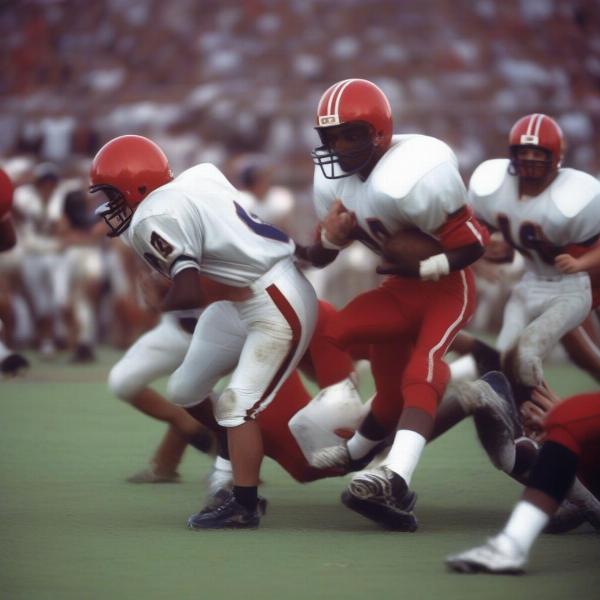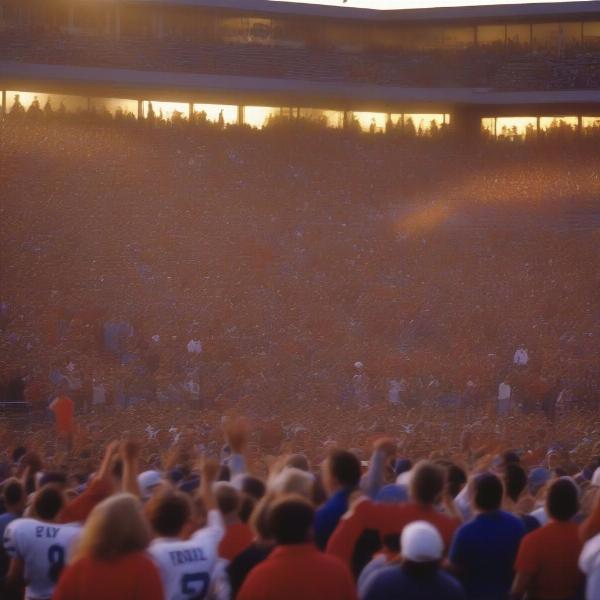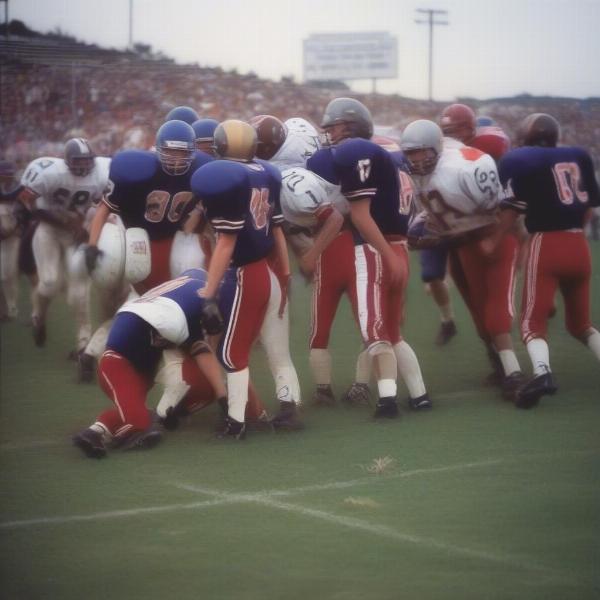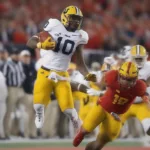The roar of the Friday night crowd, the smell of freshly cut grass, the bone-jarring tackles – these are the vivid memories that define the high school football experience of the 1990s. High school football games in the 90s weren’t just games; they were community events, cultural touchstones, and for many, the formative experiences of a lifetime. This article dives deep into what made those games so special, exploring everything from the on-field action to the vibrant atmosphere surrounding them.
The On-Field Action: A Different Era of High School Football
High school football in the 90s boasted a distinct style of play, often characterized by a more physical and less sophisticated approach than what we see today. The Wing-T offense, with its power running game, was incredibly popular, emphasizing brute force and strategic blocking. Defenses were often simpler, relying heavily on linebackers to fill gaps and strong safeties to patrol the secondary. This led to a brand of football that prioritized strength, grit, and relentless effort. Remember the legendary battles fought in the trenches? The sheer physicality was a significant part of the experience.
The Rise of the Power Running Game
The emphasis on power running made the running back a truly central figure. The star running back was often the heart and soul of the team, carrying the hopes and dreams of the entire community on his shoulders. These athletes were revered, their performances often defining the outcome of a game. Think of the legendary runs, the breathtaking touchdowns – these were iconic moments.
Defensive Strategies: Simple but Effective
While the offensive game plan often centered around power running, defensive strategies in the 90s were somewhat simpler. The focus was on stopping the run, often using formations designed to clog the middle of the field. While pass defenses existed, the emphasis was undeniably on controlling the ground game. The result was a style of play that was intense, physical, and often incredibly thrilling.
 highschool football game action 1990s
highschool football game action 1990s
Beyond the Gridiron: The Cultural Impact of High School Football in the 90s
But the 90s high school football experience was far more than just the game itself. It was a deeply ingrained part of the community fabric. Friday night lights weren’t just illuminating the field; they were illuminating the heart of small-town America.
Friday Night Lights: A Community Gathering
Friday nights weren’t just about the game; they were a social event. Families, friends, and neighbors would gather, creating a strong sense of community bonding. The tailgate parties, the halftime shows, the post-game gatherings – all these elements contributed to the vibrant atmosphere. Remember the energy? It was electric.
The Uniforms: A Symbol of Pride
The uniforms themselves represented a significant aspect of the high school football experience. These weren’t just clothing; they were symbols of pride, representing school spirit and community identity. There was a unique aesthetic to the uniforms of the 90s, a style that has since evolved, making them instantly recognizable today. Many people can still recall the exact colours and style of their high school team’s uniforms.
The Music: Defining the Decade
The music played at high school football games in the 90s reflected the sounds and trends of the era. From grunge rock anthems to the burgeoning popularity of hip-hop, the music contributed to the overall atmosphere and the memories associated with those nights.
 highschool football 90s community atmosphere
highschool football 90s community atmosphere
What Made High School Football Games in the 90s So Special?
Several factors contributed to the unique appeal of high school football games in the 90s. It was a simpler time, and the games often represented a powerful escape from everyday life.
- Simplicity and Community: The games were less complex strategically than today’s games, with a greater emphasis on physicality and team unity. This created a strong sense of community and shared experience.
- The Role of Tradition: Many schools maintained longstanding traditions, adding a unique charm to the games. These traditions served to bind the community and add a sense of continuity.
- The Absence of Over-Commercialization: The games were less commercialized, lacking the pervasive presence of advertising and sponsorships that are common today. This helped to maintain a focus on the game itself.
- The Power of Nostalgia: For many, the memories associated with 90s high school football games are intensely nostalgic, bringing back feelings of camaraderie, excitement, and a simpler time.
“The 90s were a simpler time for high school football,” says Coach Robert Miller, a veteran high school football coach with over 20 years of experience. “The emphasis was on teamwork, grit, and community spirit, values that often get lost in the modern game.”
 highschool football 90s nostalgia and memories
highschool football 90s nostalgia and memories
The Evolution of High School Football: Then and Now
High school football has evolved considerably since the 1990s. Today’s game is characterized by more sophisticated offensive and defensive schemes, a greater emphasis on player specialization, and a higher level of athleticism. While the modern game has its own merits, it has arguably lost some of the intimate community feel that defined the 90s experience.
“The game is faster, more complex, and more specialized now,” adds Coach Miller. “But there’s something to be said for the simpler style of play and the strong sense of community that characterized high school football in the 90s.”
Frequently Asked Questions
Q: What were some popular offensive and defensive strategies in 90s high school football? A: The Wing-T offense and simpler, run-stopping defenses were prevalent.
Q: How did the community involvement differ from today? A: Community involvement was more central and less commercialized.
Q: What role did music play at the games? A: Music reflected 90s trends, including grunge and hip-hop.
Q: What are some key nostalgic aspects of 90s high school football? A: Simplicity, community spirit, and the absence of extensive commercialization.
Q: How has the game evolved since the 90s? A: The game is more complex strategically and more specialized in player roles.
Q: Were there any specific technological differences compared to today’s games? A: The lack of widespread advanced video analysis and training technologies are noteworthy differences.
Q: What were some of the iconic moments or players from 90s high school football? A: This is highly dependent on the local area and varies wildly, prompting a need for personal reflection.
Conclusion
Reliving the glory days of high school football games in the 90s evokes a powerful sense of nostalgia and community. While the game has evolved, the memories and the lessons learned from those Friday night lights remain deeply cherished. Share your memories of high school football games in the 90s in the comments below!

